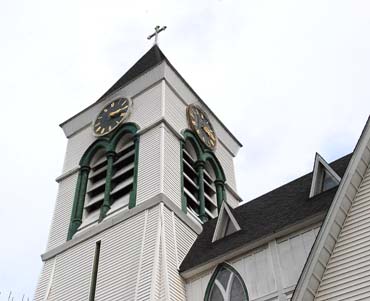Serving the Towns of Wawarsing, Crawford, Mamakating, Rochester and Shawangunk, and everything in between | |||
| |||
|
St. John's Clock Is Ticking Again!
Village Justice Becomes The New Clock Winder
ELLENVILLE – An important piece of local history will continue to tick... and show the time on all four faces. It resides in the majestic tower of St. John's Episcopal Church, up the hill on Market Street and overlooking the town that has heard its bell chimes ring out for one hundred and forty one years.
It was in 1873 that the construction of St. John's was completed, and the tower was fitted with the clock and the great bell that still serves today. That was a time when churches were being built, and steeples raised, all across the state and nation. In some ways, there are strong similarities between those times and today. The great post-Civil War boom in railroad construction, fuelled by federal government subsidies and land grants, had produced a speculators' bubble. That exploded in 1873, set off by bank failures in Vienna, capital of the Austro-Hungarian Empire. Financial crises rippled across Europe and then America, and brought on the great "panic" of latter 1873, which led to a decade of depression in markets around the world. In those days, though, there was no Federal Reserve, no bank of last resort, no FDIC insurance, and banks failed all over the country leaving angry mobs of desperate account holders outside their shuttered doors. That St. John's was finished by that point was important, because otherwise it might have lingered uncompleted for a long time. It wasn't until about 1880 that America began to pull out of that "great depression." Other interesting events of 1873 include the official completion of Central Park in New York City, the exhibition of the first barbed wire at the Illinois Country Fair, the founding of the women's temperance league following a march in Fredonia, New York, by women against retail liquor stores, and the closure, in Zanzibar's Stone Town, of one of the world's last open slave markets following pressure by the British Navy on the Sultan of Zanzibar. In those days, Ellenville was also caught up in change... From the canal, taking coal from Pennsylvania to Kingston and thence to New York, to the railroad, which could run in winter and was dooming the older mode of transport. The days of the coal barges hauled by mules was coming to an end after almost fifty years and by 1881 the canal would be forced to close. Meanwhile, the railroads, despite the depression, were opening up a new line of business for the region. It became possible for those who could afford it to send their families up to the new "Mountain Houses" that rose on the Shawangunk Ridge to escape the sweltering heat of the city in the summer. The gentlemen could commute by train on a weekly basis to spend time with their loved ones on the mountain, and return to business by train during the week. The contrast between the foul, coal smoke air and horse manure stink of a city without air conditioning, or even electric fans, and that of the ridge was remarked on by anyone who experienced it. And in those days Ellenville was home to many churches, although St. John's led the way and its great bell rang out across the village and up to the mountain slopes, ringing off the hours throughout each day, and then on Sundays, summoning the faithful to morning and evening services... and reminding them of the time. There is no name on the clock to give us the manufacturer. But the bell is inscribed and came from the Meneely Bell Foundry, of West Troy and is dated 1873. That foundry had begun in 1826, and together with a sister company cast 65,000 bells before it closed in 1952. Today, there is one remaining American bell foundry, McShane's of Glen Burnie, Maryland. The clock mechanism, which still operates perfectly, has to be wound once a week. For most of the Reverend Jeff Goliher's tenure at St. John's, the clock winding was done by Bill Crane, who took great pride in the job. Now, Matt Parker, judge for the Ellenville Village Court, has taken on the task... Which means climbing some narrow stairs to the clock winding station, and winding the mechanism for another week. "I call myself the 'Keeper of the Clock'," says Parker with a grin. "I wind it every Sunday." Once, of course, the clock rang out the hours, day and night, but in recent times neighbors found the sound of the bell disturbed their sleep. So now, it is rung only on Sundays for church services. However, tradition continues and the four clock faces of St. John's church continue to provide the time for anyone passing by who looks up. All from one central mechanism. Like so many things once you stop to think about it...
Copyright © 2014, Electric Valley Media LLC | Terms of Use
All Rights Reserved. |
     |




